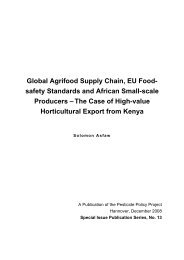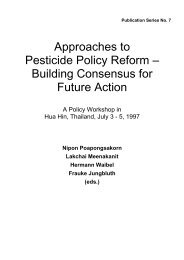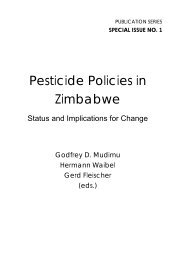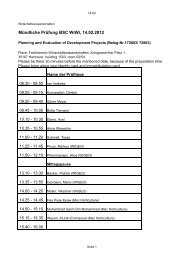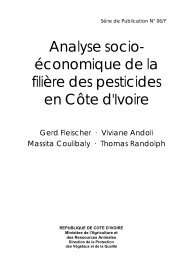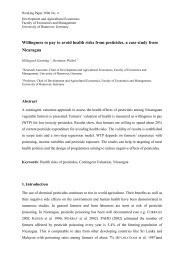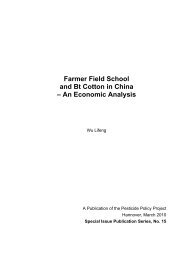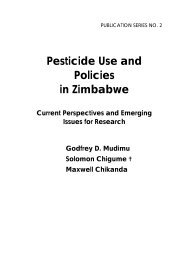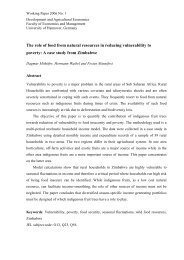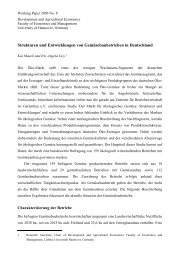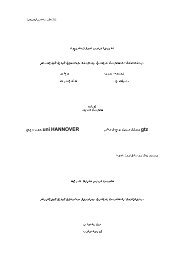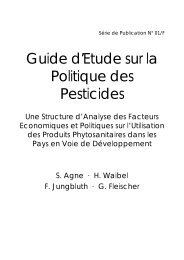Attitudes towards risk and time among small-scale farmers in West ...
Attitudes towards risk and time among small-scale farmers in West ...
Attitudes towards risk and time among small-scale farmers in West ...
Create successful ePaper yourself
Turn your PDF publications into a flip-book with our unique Google optimized e-Paper software.
<strong>Attitudes</strong> <strong>towards</strong> <strong>risk</strong> <strong>and</strong> <strong>time</strong> <strong>among</strong> <strong>small</strong>-<strong>scale</strong> <strong>farmers</strong> <strong>in</strong> <strong>West</strong> Africa<br />
SABINE LIEBENEHM* AND HERMANN WAIBEL*<br />
*Leibniz Universität Hannover, Institute of Development <strong>and</strong> Agricultural Economics,<br />
Hannover, Germany<br />
Abstract<br />
This study presents an advanced methodology of jo<strong>in</strong>tly elicit<strong>in</strong>g attitudes <strong>towards</strong> <strong>risk</strong> <strong>and</strong><br />
<strong>time</strong> <strong>and</strong> the subjective perception of uncerta<strong>in</strong>ty <strong>among</strong> 212 <strong>small</strong>holder cattle <strong>farmers</strong> <strong>in</strong> the<br />
cotton belt of <strong>West</strong> Africa. The sample had been r<strong>and</strong>omly selected from a panel of previous<br />
socio-economic survey samples <strong>in</strong> 2003/2004 <strong>and</strong> 2007 <strong>in</strong> the study area. All respondent<br />
<strong>farmers</strong> face the same problem, i.e. manag<strong>in</strong>g African animal trypanosomosis (AAT) a major<br />
livestock disease <strong>in</strong> cattle <strong>and</strong> its widespread resistance to commonly available drugs.<br />
Because of the dynamic nature of the disease <strong>and</strong> its strong <strong>in</strong>terdependency with farmer’s<br />
behavior <strong>and</strong> perception of uncerta<strong>in</strong> events it is useful to exp<strong>and</strong> the measurement of <strong>risk</strong><br />
attitudes <strong>and</strong> simultaneously elicit <strong>farmers</strong>’ <strong>time</strong> preferences <strong>and</strong> subjective probabilities of<br />
cattle’s health states.<br />
In total, five economic field experiments had been conducted dur<strong>in</strong>g January <strong>and</strong> February<br />
2011 <strong>in</strong> the study area common to southeastern Mali <strong>and</strong> southwestern Burk<strong>in</strong>a Faso that<br />
are <strong>in</strong>troduced <strong>in</strong> this paper. First prelim<strong>in</strong>ary results show that the general perception of the<br />
threat of cattle diseases is serious <strong>and</strong> AAT is <strong>among</strong> the most important one. Furthermore,<br />
respondents seem to be rather <strong>risk</strong>-seek<strong>in</strong>g. The <strong>time</strong> preference experiment showed that<br />
40% of respondents are rather patient <strong>and</strong> wait for a higher future reward.<br />
Key words: experiments, <strong>risk</strong> <strong>and</strong> <strong>time</strong> preferences, dynamics, <strong>West</strong> Africa
1 Background<br />
African animal trypanosomosis (AAT) <strong>in</strong> cattle <strong>and</strong> the threat of widespread drug resistance<br />
are important production <strong>risk</strong>s to resource-poor cattle <strong>farmers</strong> <strong>in</strong> <strong>small</strong>holder crop-livestock<br />
production systems <strong>in</strong> the cotton belt of <strong>West</strong> Africa (Clausen et al., 2010). Recent studies <strong>in</strong><br />
that region underl<strong>in</strong>e the urgency to improve the underst<strong>and</strong><strong>in</strong>g of drug resistance<br />
development <strong>and</strong> to f<strong>in</strong>d ways of its susta<strong>in</strong>able conta<strong>in</strong>ment <strong>and</strong> prevention (Affognon et al.,<br />
2005, Grace et al., 2009). The development of resistance <strong>in</strong> pathogens to tryopanocidal<br />
compounds is <strong>in</strong>fluenced not only by the <strong>in</strong>teractions of factors related to respective<br />
characteristics of pathogen, vector <strong>and</strong> host <strong>in</strong>volved, but also by human <strong>in</strong>terference (Geerts<br />
& Holmes, 1998). S<strong>in</strong>ce early studies, the exposure of trypanosomes to sub-therapeutic drug<br />
doses has been considered as a key factor for the development of resistance (Boyt, 1986,<br />
Whiteside, 1960, 1962). Hence, one can argue that <strong>farmers</strong>’ decision mak<strong>in</strong>g is the ‘lynchp<strong>in</strong>’<br />
for <strong>in</strong>troduc<strong>in</strong>g better disease <strong>and</strong> resistance management options. Decision outcomes are<br />
uncerta<strong>in</strong> <strong>and</strong> are of a long-term nature, because the success of the treatment is <strong>in</strong>fluenced<br />
by r<strong>and</strong>om events <strong>and</strong> consequences are delayed. In this context the decision mak<strong>in</strong>g<br />
behavior of <strong>farmers</strong> with regard to three factors, namely (i) the perception of uncerta<strong>in</strong><br />
events, (ii) attitudes <strong>towards</strong> <strong>risk</strong> <strong>and</strong> (iii) <strong>time</strong> preferences are crucial parameters. Therefore,<br />
the overall aim of this study is to generate a better underst<strong>and</strong><strong>in</strong>g of <strong>farmers</strong>’ behavior by<br />
means of economic field experiments.<br />
Economic field experiments <strong>in</strong> develop<strong>in</strong>g countries elicit<strong>in</strong>g people’s <strong>risk</strong> preferences have a<br />
long tradition. For example, B<strong>in</strong>swanger (1980, 1981) conducted a ‘choose lottery’ with rural<br />
<strong>farmers</strong> <strong>in</strong> India, Harrison et al. (2005) <strong>in</strong> Ethiopia <strong>and</strong> Ug<strong>and</strong>a <strong>and</strong> Yesuf <strong>and</strong> Bluffstone<br />
(2009) <strong>in</strong> Ethiopia. In contrast to those choose lotteries, which conta<strong>in</strong> alternative choices,<br />
Holt <strong>and</strong> Laury (2002) developed ‘accept/reject lotteries, where participants are confronted<br />
with a pair-wise lottery choice <strong>in</strong> two columns. All these studies had been limited to <strong>risk</strong><br />
preferences.<br />
More recent studies conduct<strong>in</strong>g economic field experiments aimed to jo<strong>in</strong>tly elicit <strong>risk</strong> <strong>and</strong><br />
<strong>time</strong> preferences. Most of these studies took place <strong>in</strong> the developed world (e.g. Andersen et<br />
al. (2008) <strong>in</strong> Denmark or Ida & Goto (2009) <strong>in</strong> Japan). With respect to experimental work <strong>in</strong><br />
develop<strong>in</strong>g countries, Tanaka et al. (2010) conducted experiments with rural villagers <strong>in</strong><br />
Vietnam. They exp<strong>and</strong>ed the measurement of <strong>risk</strong> attitudes beyond the only parameter of<br />
concavity underly<strong>in</strong>g expected utility theory to test Tversky <strong>and</strong> Kahnemann (1992)’s<br />
prospect theory. By means of prospect theory more <strong>in</strong>sights <strong>in</strong>to economic behavior can be<br />
obta<strong>in</strong>ed, <strong>in</strong>clud<strong>in</strong>g subject’s loss aversion as compared to ga<strong>in</strong>s <strong>and</strong> the weight<strong>in</strong>g of<br />
probabilities (Humphrey & Verschoor, 2004). Moreover, Tanaka et al. (2010)’s <strong>time</strong><br />
preference experiment had been designed <strong>in</strong> a way to test several forms of discount<strong>in</strong>g, i.e.<br />
exponential, hyperbolic <strong>and</strong> quasi-hyperbolic discount<strong>in</strong>g, as recommended by Benhabib et<br />
al. (2010).<br />
Dynamic economic experiments <strong>in</strong> which subjects are confronted with a decision problem<br />
across repeated rounds can be ma<strong>in</strong>ly found <strong>in</strong> the field of microf<strong>in</strong>ance (e.g. Abb<strong>in</strong>k et al.,<br />
2006, G<strong>in</strong>é et al., 2010). In the field of agricultural economics, the work of Lybbert (2006) is<br />
one of the first that assessed farmer’s <strong>risk</strong>y decision mak<strong>in</strong>g across repeated rounds of<br />
hypothetical farm<strong>in</strong>g seasons us<strong>in</strong>g the case of new crop varieties.<br />
The objective of the paper is (i) to describe the implementation of economic field experiments<br />
to jo<strong>in</strong>tly elicit perceptions, <strong>risk</strong> attitudes <strong>and</strong> <strong>time</strong> preferences of African cattle <strong>farmers</strong> <strong>in</strong> the<br />
cotton belt of Mali <strong>and</strong> Burk<strong>in</strong>a Faso <strong>and</strong> (ii) to present prelim<strong>in</strong>ary results to allow first<br />
assessment of the validity of these experiments.<br />
In the next section the procedures of data collection are presented, followed by the<br />
methodology of jo<strong>in</strong>tly elicit<strong>in</strong>g perceptions <strong>and</strong> preferences <strong>in</strong> section three <strong>and</strong> prelim<strong>in</strong>ary<br />
results <strong>in</strong> section four. F<strong>in</strong>ally, section five concludes.<br />
2
2 Data<br />
The empirical bases for conduct<strong>in</strong>g economic field experiments <strong>in</strong> <strong>West</strong> Africa were prior<br />
studies of the first author <strong>and</strong> other researchers of the International Livestock Research<br />
Institute (ILRI). In the study area of Mali <strong>and</strong> Burk<strong>in</strong>a Faso two socio-economic surveys had<br />
been already conducted <strong>in</strong> 2003/2004 (Affognon et al., 2010) <strong>and</strong> <strong>in</strong> 2007 (Liebenehm et al.,<br />
2011). From January to February 2011 the study area had been visited aga<strong>in</strong>, to elicit<br />
<strong>farmers</strong>’ perception of uncerta<strong>in</strong>ty <strong>and</strong> <strong>risk</strong> <strong>and</strong> <strong>time</strong> preferences. Table 1 presents the<br />
number of households <strong>in</strong> previous <strong>and</strong> present surveys.<br />
Table 1 here<br />
In the basel<strong>in</strong>e sample of 2003/2004 detailed <strong>in</strong>formation about cattle production had been<br />
obta<strong>in</strong>ed from 206 households (Affognon et al., 2010). In 2007 it was aimed to measure the<br />
impact of ILRI's project <strong>in</strong>tervention. Here, 117 households could be matched to the former<br />
basel<strong>in</strong>e sample <strong>and</strong> 306 were used as controls (Liebenehm et al., 2011) 1 . In 2011 it was<br />
aimed to r<strong>and</strong>omly select 100 observations from those households that already participated<br />
<strong>in</strong> the previous two surveys <strong>and</strong> another 100 households that already participated <strong>in</strong> the 2007<br />
survey. In the end the experiments had been conducted with 98 households, where<br />
production <strong>in</strong>formation from two po<strong>in</strong>ts <strong>in</strong> <strong>time</strong> is available <strong>and</strong> 114 households, where<br />
production data from 2007 is available.<br />
The first part of the questionnaire focused on household demographics <strong>and</strong> cattle herd<br />
production <strong>in</strong> accordance to previous surveys. In the second part <strong>farmers</strong> were asked to<br />
participate <strong>in</strong> five experiments. Detailed guidel<strong>in</strong>es of each experiment had been prepared <strong>in</strong><br />
cooperation with other economists <strong>and</strong> veter<strong>in</strong>ary experts. All materials had been expla<strong>in</strong>ed<br />
to experienced enumerators, who already took part <strong>in</strong> the former surveys <strong>and</strong> were familiar<br />
with the topic of AAT <strong>and</strong> the study area. Role games between enumerators helped to<br />
establish a common <strong>in</strong>terviewer st<strong>and</strong>ard <strong>and</strong> to m<strong>in</strong>imize enumerators’ bias. F<strong>in</strong>ally, the<br />
questionnaire had been pre-tested <strong>in</strong> one village. The survey team visited each village <strong>in</strong><br />
advance to <strong>in</strong>troduce the venture <strong>and</strong> provide the lists of names <strong>in</strong> order to ensure that the<br />
r<strong>and</strong>omly drawn respondents were present.<br />
3 Experimental design<br />
In this study five economic field experiments had been conducted (Table 2). Subjective (jo<strong>in</strong>t)<br />
probability judgments were <strong>in</strong>ferred by the visual impact method (Hardaker et al., 2004).<br />
There were three different types of <strong>risk</strong> experiments. The first one had been designed as a<br />
b<strong>in</strong>ary choice between a lottery <strong>and</strong> safe amount to calculate the <strong>in</strong>difference po<strong>in</strong>t (or<br />
certa<strong>in</strong>ty equivalent) for a <strong>risk</strong>y option (Hardeweg et al., 2011, Henrich & McElreath, 2002).<br />
The second <strong>risk</strong> experiment was designed as ‘accept/reject lotteries’ <strong>in</strong> order to elicit the<br />
three parameters of prospect theory, i.e. (i) concavity of the utility function, (ii) non-l<strong>in</strong>ear<br />
probability weight <strong>and</strong> (iii) degree of loss aversion <strong>in</strong> relation to ga<strong>in</strong>s (Tanaka et al., 2010).<br />
The third <strong>risk</strong> game was rather a strategic game suited to the decision problem <strong>in</strong> manag<strong>in</strong>g<br />
the disease. F<strong>in</strong>ally, <strong>in</strong> the <strong>time</strong> experiment participants basically had the choice between an<br />
immediate <strong>and</strong> a delayed reward (Tanaka et al., 2010).<br />
3.1 Experiment on <strong>risk</strong> perception<br />
Table 2 here<br />
Subjective (jo<strong>in</strong>t) probability judgments had been <strong>in</strong>ferred by the visual impact method (VIM).<br />
VIM is a tabular approach to obta<strong>in</strong> probability distributions by ask<strong>in</strong>g the participant about<br />
1 In the research output from 2007 the <strong>in</strong>formation of respondents’ self-report of participation has been<br />
used to dist<strong>in</strong>guish between participants <strong>and</strong> non-participants (Liebenehm et al. 2011).<br />
3
their probability judgment of uncerta<strong>in</strong> events us<strong>in</strong>g counters that represent relative<br />
probabilities. Mostly, sources of uncerta<strong>in</strong>ty are <strong>in</strong>terdependent <strong>and</strong> VIM makes it possible to<br />
account for stochastic dependency by elicit<strong>in</strong>g jo<strong>in</strong>t probabilities (Hardaker et al., 2004).<br />
In a first step, the respondent had been asked how often <strong>in</strong> the next 12 months he expects<br />
his cattle to be healthy, <strong>in</strong>fected with AAT or <strong>in</strong>fected with another disease. With the help of<br />
counters (cotton swabs) the respondent was asked to allocate the 12 counters <strong>in</strong> the way he<br />
th<strong>in</strong>ks how often the respective proposition will occur <strong>in</strong> the next 12 months. In case the<br />
respondent assigned at least one counter to AAT, he was asked to cont<strong>in</strong>ue with the next<br />
question, i.e. ‘In case you believe your cattle will be <strong>in</strong>fected with AAT, how often you th<strong>in</strong>k<br />
they will be <strong>in</strong>fected with resistant or sensitive stra<strong>in</strong>s?’ Aga<strong>in</strong> the respondent had been<br />
asked to re-allocate the number of counters assigned to AAT <strong>in</strong> the first question over the<br />
two possible types of AAT <strong>in</strong>fection. The number of counters assigned <strong>in</strong> the first step was<br />
multiplied by two to ensure the number of counters is sufficient for reallocation. In the third<br />
step, given the particular jo<strong>in</strong>t probability of AAT <strong>and</strong> the respective type of <strong>in</strong>fection, the<br />
respondent was asked to judge about the percentage of cattle dy<strong>in</strong>g <strong>and</strong> output loss with <strong>and</strong><br />
without medical treatment, each on a 5-<strong>scale</strong> <strong>in</strong>terval from 0% to 100%. In order to facilitate<br />
reallocation of counters the number of counters <strong>in</strong> the second step was multiplied by five.<br />
Respective tables were provided as picture cards to facilitate the arrangement of counters.<br />
After each question the respondent was asked to thoroughly check all values <strong>in</strong> the tables<br />
aga<strong>in</strong> to make sure that the allocation of counters corresponds to personal beliefs.<br />
3.2 Experiments on <strong>risk</strong> preferences<br />
In the follow<strong>in</strong>g three <strong>risk</strong> experiments are described to some detail.<br />
3.2.1 Risk game I<br />
Respondent were asked to choose <strong>among</strong> 20 decision problems between an identical lottery<br />
(Option A) <strong>and</strong> <strong>in</strong>creas<strong>in</strong>g safe pay-off (Option B). In the lottery a bl<strong>in</strong>d draw of one red or one<br />
yellow chip out of a bag decided about a payoff of zero or 1500 CFA (about 2 €). The certa<strong>in</strong><br />
amount started with 0 CFA <strong>and</strong> <strong>in</strong>creases by 50 CFA row by row up to 950 CFA <strong>in</strong> the last<br />
row. Hence, the preference of a safe amount below 750 CFA implies that respondents are<br />
<strong>risk</strong>-averse. The preference of a safe amount above 750 CFA implies <strong>risk</strong>-seek<strong>in</strong>g behavior<br />
(Table 3).<br />
Table 3 here<br />
The respondent was asked to select the row, where he would switch from Option A to Option<br />
B. The respondent could switch <strong>in</strong> the first row, <strong>and</strong> he did not have to switch at all. In total,<br />
there were 20 choices to make <strong>and</strong> the row number had been noted down <strong>in</strong> the<br />
questionnaire.<br />
After the completion of all 20 choices, the respondent was asked to draw one card out of a<br />
bag with 20 numbered cards. If this number on the card drawn is lower than the row number<br />
that <strong>in</strong>dicates the switch<strong>in</strong>g po<strong>in</strong>t from Option A to B, the respondent had to play the lottery. If<br />
the number on the card drawn is higher than the row number, the respondent receives the<br />
safe amount of the row <strong>in</strong>dicated by the r<strong>and</strong>omly drawn number.<br />
3.2.2 Risk game II<br />
Three series of paired lotteries had been conceptualized <strong>in</strong> order to exp<strong>and</strong> the<br />
measurement of <strong>farmers</strong>’ <strong>risk</strong> preferences beyond the concavity of the utility function, tak<strong>in</strong>g<br />
<strong>in</strong>to account the <strong>in</strong>fluence of non-l<strong>in</strong>ear weight<strong>in</strong>g of probabilities <strong>and</strong> the aversion of losses<br />
as compared to ga<strong>in</strong>s.<br />
4
In each series, the respondent had the choice between two options, i.e. Option A <strong>and</strong> Option<br />
B, whereby each option is a lottery out of 10 colored chips with different rewards to be<br />
obta<strong>in</strong>ed (Table 4). The difference <strong>in</strong> expected pay-offs of Option A relative to Option B is<br />
shown <strong>in</strong> the right column. In series 1, probabilities are fixed <strong>in</strong> all 14 rows <strong>and</strong> only the high<br />
pay-off <strong>in</strong> Option B <strong>in</strong>creases <strong>in</strong> every row. Hence, Option A dom<strong>in</strong>ates Option B <strong>in</strong> the first<br />
seven rows <strong>in</strong> terms of expected pay-off. From row eight to 14 Option B starts to dom<strong>in</strong>ate<br />
Option A. Series 2 shows the same pattern like Series 1, but different pay-offs <strong>and</strong><br />
probabilities. Here, Option B immediately starts to dom<strong>in</strong>ate Option A <strong>in</strong> terms of expected<br />
pay-off from the first row. Those who are <strong>risk</strong>-averse will choose Option A longer than those<br />
who are rather <strong>risk</strong>-tak<strong>in</strong>g. The third series <strong>in</strong>volves both ga<strong>in</strong>s <strong>and</strong> losses. Probabilities are<br />
fixed at 50:50 for all rows. In Option A the positive pay-off decreases, while the negative payoff<br />
<strong>in</strong>creases from row to row. In Option B the positive pay-off is constantly high, <strong>and</strong> the<br />
negative pay-off decreases row by row.<br />
Table 4 here<br />
In each series, the participant was asked, which option he would accept, at the same <strong>time</strong><br />
reject<strong>in</strong>g the other one. Basically, the respondent could choose Option B <strong>in</strong> the first row <strong>and</strong><br />
he did not have to switch to Option B at all. In total, there were 35 choices to make. After the<br />
completion of all 35 choices, the respondent was asked to bl<strong>in</strong>dly draw one card out of 35<br />
numbered cards <strong>in</strong> a bag. The card drawn determ<strong>in</strong>ed the row of choice <strong>and</strong> the respective<br />
ten colored chip lottery had been played for real money.<br />
The largest reward of 50000 CFA (about 76 €) is equivalent to 15% of the average annual<br />
<strong>in</strong>come of a cattle dependent household <strong>in</strong> the study area. The maximum amount that could<br />
have been lost by the respondent was 1000 CFA (about 1.5 €), which equalled the amount<br />
the respondent had been paid when he agreed to participate <strong>in</strong> the survey at the very<br />
beg<strong>in</strong>n<strong>in</strong>g. As visual aid picture cards were used <strong>in</strong> order to account for the low educational<br />
background of respondents <strong>in</strong> the study area (Liebenehm et al 2011). The picture cards<br />
illustrated each lottery <strong>in</strong> each series with rewards or losses <strong>and</strong> respective probabilities as<br />
<strong>in</strong>dicated by differently colored chips.<br />
3.2.3 Risk game III<br />
The dynamic <strong>risk</strong> game aimed to better underst<strong>and</strong> <strong>farmers</strong>’ valuation of AAT treatment<br />
options by evaluat<strong>in</strong>g pay-off distributions that depend on the chosen <strong>in</strong>put. The respondent<br />
was asked to play three series of hypothetical farm<strong>in</strong>g seasons to allow for learn<strong>in</strong>g across<br />
repeated rounds. At the beg<strong>in</strong>n<strong>in</strong>g of each season the respondent was confronted with the<br />
yield distribution of his hypothetical cattle herd. Therefore, he was asked to bl<strong>in</strong>dly draw ten<br />
chips out of a bag with 20 chips <strong>in</strong> three different colors (10 white chips, 7 green chips <strong>and</strong> 3<br />
blue chips). The three different colors represent the three different health states of cattle,<br />
namely healthy (white), sensitive <strong>in</strong>fection with AAT (green) <strong>and</strong> resistant <strong>in</strong>fection with AAT<br />
(blue). That means the <strong>risk</strong> of <strong>in</strong>fection with AAT is 50%, whereby 15% of those <strong>in</strong>fected<br />
animals will be <strong>in</strong>fected with resistant stra<strong>in</strong>s. The ten bl<strong>in</strong>dly drawn chips were put on the<br />
soil <strong>in</strong> front of the respondent. Now the respondent knew the health state of his hypothetical<br />
cattle herd <strong>and</strong> the potential yield that can be produced <strong>in</strong> this first season could be<br />
calculated (1 white chip=1000 CFA, 1 green chip=500 CFA, 1 blue chip=250 CFA). Only 10%<br />
of this <strong>in</strong>come generated by the hypothetical cattle herd could be exclusively used by the<br />
respondent to <strong>in</strong>vest <strong>in</strong> health of his cattle herd, whereby 90% of this money was said to be<br />
spent for support<strong>in</strong>g the family, etc 2 . Thereafter, the respondent was shown four different<br />
treatment options <strong>and</strong> correspond<strong>in</strong>g physical outcomes <strong>and</strong> monetary consequences (Table<br />
5).<br />
2 Follow<strong>in</strong>g Shaw et al. (2006) the relation between average live weight price of Zebus <strong>and</strong><br />
trypanocide cost are 100 to 1. In this game, the value of cattle <strong>and</strong> treatment costs are adjusted to 100<br />
to 10 to reflect the difficult situation of mak<strong>in</strong>g a treatment decision under strong monetary constra<strong>in</strong>ts.<br />
5
Table 5 here<br />
Each treatment strategy can result <strong>in</strong>to different outcomes that <strong>in</strong>dicate possible reactions<br />
with respect to cattle’s health state. In turn, each outcome comes with a certa<strong>in</strong> probability.<br />
There are 4x20 chips represent<strong>in</strong>g the four treatment options, whereby number <strong>and</strong> color of<br />
the chips follow the probabilities of respective outcomes. The respondent could choose<br />
several options, each for one animal. The only constra<strong>in</strong>t had been the budget available for<br />
treatment. After the respondent made his choice he was asked to state his will<strong>in</strong>gness to pay<br />
(WTP) for the chosen strategies follow<strong>in</strong>g a mechanism suggested by Becker, DeGroot <strong>and</strong><br />
Marschak (1964). In case respondent’s WTP was higher than a r<strong>and</strong>om draw of <strong>in</strong>put price<br />
from a uniform distribution of prices of the respective strategy, the chosen strategy would be<br />
applied. In case his WTP was lower than the r<strong>and</strong>om draw of <strong>in</strong>put price, no treatment would<br />
be applied. The r<strong>and</strong>om draw of <strong>in</strong>put price had been determ<strong>in</strong>ed by a roll of a ten-sided-die,<br />
whereby 1 <strong>in</strong>dicates a price of 100 CFA <strong>and</strong> 10 <strong>in</strong>dicates a price of 1000 CFA. In<br />
correspondence to the result<strong>in</strong>g strategy applied, the respondent was given the respective<br />
bag <strong>and</strong> was asked to bl<strong>in</strong>dly draw one chip out of the bag. The cattle health state of the<br />
hypothetical herd, represented by the ten chips on the soil, was adjusted accord<strong>in</strong>g to the<br />
respective consequences result<strong>in</strong>g from the bl<strong>in</strong>dly drawn chip. F<strong>in</strong>ally, the profit <strong>in</strong> the end of<br />
the first season could be determ<strong>in</strong>ed. In order to account for natural reproduction, one white<br />
chip (1000 CFA) was added to the hypothetical herd. In the next round the respondent could<br />
choose <strong>among</strong> the four treatment options aga<strong>in</strong>, us<strong>in</strong>g 10% of the production value obta<strong>in</strong>ed<br />
<strong>in</strong> the previous round. In total three rounds were played. At the end, the respondent obta<strong>in</strong>ed<br />
10% of the f<strong>in</strong>al production value <strong>in</strong> cash. Picture cards had been used to illustrate the<br />
course of the game <strong>and</strong> to make it easier for the respondent to remember each strategy with<br />
correspond<strong>in</strong>g outcomes.<br />
3.3 Experiment on <strong>time</strong> preferences<br />
The <strong>time</strong> preference experiment aimed to test several functional forms of discount<strong>in</strong>g<br />
consists of 75 choices <strong>in</strong> total between two options, i.e. a larger reward delivered at a<br />
specified <strong>time</strong> <strong>in</strong> the future (Option A) <strong>and</strong> a <strong>small</strong>er reward delivered immediately (Option B).<br />
The future reward varies between 1500 CFA (about 2.3 €) <strong>and</strong> 15000 CFA (about 23 €).<br />
There are 15 comb<strong>in</strong>ations of future rewards <strong>and</strong> <strong>time</strong> delays, i.e. 1500 CFA, 6000 CFA <strong>and</strong><br />
15000 CFA with delays of one week, one month <strong>and</strong> three months, respectively <strong>and</strong> 3000<br />
CFA <strong>and</strong> 12000 CFA with delays of three days, two weeks <strong>and</strong> two months. The maximum<br />
delay of three months corresponds to treatment decisions <strong>in</strong> manag<strong>in</strong>g the disease. Each of<br />
those 15 comb<strong>in</strong>ations of rewards <strong>and</strong> delays is opposed to five different rewards that can be<br />
obta<strong>in</strong>ed immediately. The respondent had to decide row by row which option he prefers.<br />
After the completion of all 75 choices, the respondent was asked to bl<strong>in</strong>dly draw one ball out<br />
of 75 numbered b<strong>in</strong>go balls <strong>in</strong> a box. The ball drawn will determ<strong>in</strong>e the row <strong>and</strong> the<br />
participant ga<strong>in</strong> the reward at the respective <strong>time</strong> accord<strong>in</strong>g to his choice made. A trusted<br />
agent, well-known <strong>and</strong> commonly accepted for this duty, had been assigned to keep the<br />
money until delivery.<br />
4 Descriptive results<br />
4.1 Risk perception<br />
The jo<strong>in</strong>t probabilities elicited by means of the visual impact method (VIM) are presented <strong>in</strong><br />
Figure 1.<br />
Figure 1 here<br />
6
The average subjective probability that cattle will stay healthy <strong>in</strong> the next twelve months is<br />
44.51%, followed by trypanosomosis with 29.21% <strong>and</strong> other cattle diseases with 26.28%.<br />
Therefore, the general perception of cattle diseases <strong>among</strong> respondents is that they are a<br />
serious problem <strong>and</strong> AAT is <strong>among</strong> the most important one. Given the <strong>in</strong>cidence of AAT <strong>in</strong><br />
the next twelve months the jo<strong>in</strong>t probability that cattle will be <strong>in</strong>fected with sensitive stra<strong>in</strong>s is<br />
higher than an <strong>in</strong>fection with drug-resistant stra<strong>in</strong>s. Further along the probability tree, the<br />
outcomes of each type of AAT <strong>in</strong>fection on the percentage of herd mortality <strong>and</strong> output loss<br />
<strong>in</strong> monetary terms are different. The average subjective probability of higher monetary losses<br />
is higher than <strong>in</strong> terms of mortality <strong>in</strong> case of a sensitive <strong>in</strong>fection with AAT <strong>and</strong> vice versa <strong>in</strong><br />
case of a resistant <strong>in</strong>fection. This observation is plausible, because a resistant <strong>in</strong>fection is<br />
less likely to be successfully cured. The comparisons of outcomes with <strong>and</strong> without<br />
trypanocidal control are similar <strong>among</strong> the two types of AAT <strong>in</strong>fection. In both cases the<br />
percentage of loss is perceived to be <strong>small</strong>er with control than without any means of AAT<br />
control both <strong>in</strong> terms of monetary loss <strong>and</strong> herd mortality.<br />
4.2 Risk preferences<br />
4.2.1 Risk game I<br />
The cumulative distribution of switch<strong>in</strong>g po<strong>in</strong>ts from a lottery (1500CFA or 0CFA) to an<br />
<strong>in</strong>creas<strong>in</strong>g safe amount is presented <strong>in</strong> Figure 2.<br />
Figure 2 here<br />
Almost 70% out of 212 participat<strong>in</strong>g cattle <strong>farmers</strong> never switched to the safe amount.<br />
Instead, they always preferred to play the lottery. In contrast, the rema<strong>in</strong><strong>in</strong>g 30% of the<br />
respondents switched rather sooner than later along the rows. They prefer obta<strong>in</strong><strong>in</strong>g a <strong>small</strong><br />
safe reward than to play the lottery. Hence, the majority of <strong>risk</strong>-tak<strong>in</strong>g cattle <strong>farmers</strong> of 70%<br />
are opposed to 30% of <strong>risk</strong>-averse <strong>farmers</strong>.<br />
4.2.2 Risk game II<br />
Table 6 displays the number of respondents by switch<strong>in</strong>g po<strong>in</strong>ts <strong>in</strong> series one, two <strong>and</strong> three.<br />
Table 6 here<br />
There are respondents at any given switch<strong>in</strong>g po<strong>in</strong>t from A to B, <strong>in</strong>clud<strong>in</strong>g the option to never<br />
switch, which shows that the experimental <strong>in</strong>structions had been understood. Focus<strong>in</strong>g on<br />
the switch<strong>in</strong>g po<strong>in</strong>ts <strong>in</strong> series one <strong>and</strong> two, the majority of respondents are rather earlier<br />
switch<strong>in</strong>g to Option B than later down the rows, try<strong>in</strong>g to obta<strong>in</strong> a higher reward at higher <strong>risk</strong>.<br />
In contrast, 35 of 212 respondents never switched to Option B, to back up at least 500 CFA<br />
at lower <strong>risk</strong>. Hence, <strong>in</strong> correspondence to <strong>risk</strong> game I, the majority of respondents shows<br />
<strong>risk</strong>-seek<strong>in</strong>g behavior.<br />
In series three the distribution of respondents by switch<strong>in</strong>g po<strong>in</strong>t is similar. Around 60% of<br />
respondents are rather likely to switch <strong>in</strong> the beg<strong>in</strong>n<strong>in</strong>g, tak<strong>in</strong>g <strong>in</strong>to account to loose a high<br />
amount of money. Approximately, 30% of respondents never switched to Option B, be<strong>in</strong>g<br />
rather loss-averse.<br />
4.2.3 Risk game III<br />
In dependence of r<strong>and</strong>omly drawn health state chips, the respondents started with a<br />
hypothetical cattle herd that could produce on average a value of 7100 CFA, which<br />
corresponds to the expected value when draw<strong>in</strong>g 10 out of 20 chips from the starter-bag.<br />
While after the first round the mean value of herd production decreases slightly, the value of<br />
production is <strong>in</strong>creas<strong>in</strong>g by 1000 CFA after Round 2 <strong>and</strong> Round 3 (Figure 3). In consideration<br />
7
of the fact that this <strong>in</strong>crease <strong>in</strong> value of production excludes the natural reproduction <strong>in</strong> terms<br />
of additional 1000 CFA after each round, it shows that respondents were on average able to<br />
improve the health states of their cattle.<br />
Figure 3 here<br />
Figure 4 presents the four strategies chosen <strong>and</strong> actually applied, i.e. no treatment (A),<br />
curative (B), preventive (C) <strong>and</strong> sanative (D) strategies <strong>in</strong> each round. Around 60% of<br />
respondents chose the curative treatment strategy, followed by sanative pair <strong>and</strong> preventive<br />
treatment across all rounds. However, <strong>in</strong> most cases no treatment is applied <strong>in</strong> the end. The<br />
order of all other strategies applied follow<strong>in</strong>g beh<strong>in</strong>d corresponds to the chosen ones.<br />
Figure 4 here<br />
Figure 5 shows the mean will<strong>in</strong>gness to pay by strategy <strong>and</strong> the average r<strong>and</strong>omly drawn<br />
prices determ<strong>in</strong>ed by a ten-sided die. On average r<strong>and</strong>om prices are higher than<br />
respondents’ WTP, which expla<strong>in</strong>s that mostly no treatment strategy (A) is applied <strong>in</strong> the end<br />
of each round.<br />
Figure 5 here<br />
Noticeable, is also the fact that respondents <strong>in</strong>crease their WTPs for all strategies B, C <strong>and</strong> D<br />
across the three rounds <strong>and</strong> the percentage of those strategies actually applied is <strong>in</strong>creas<strong>in</strong>g,<br />
too (Figure 4).<br />
Moreover, it can be observed that <strong>in</strong> the first round respondents were will<strong>in</strong>g to spend only<br />
half of the budget available for treatment. After each follow<strong>in</strong>g round they are <strong>in</strong>creas<strong>in</strong>g their<br />
WTP steadily <strong>in</strong> accordance to an <strong>in</strong>creased production value <strong>and</strong> result<strong>in</strong>g budget.<br />
Respondents were will<strong>in</strong>g to spent most of the budget for sanative pair (D), followed by<br />
curative treatment (B) <strong>and</strong> preventive treatment (C) <strong>in</strong> Round 1 <strong>and</strong> Round 2. In the third<br />
round, the WTP for preventive treatment is on average higher than for curative treatment.<br />
The highest WTP for strategy D (sanative pair) corresponds to the highest expected value<br />
that could have been obta<strong>in</strong>ed by this choice, which shows that respondents understood the<br />
game quite well <strong>and</strong> are act<strong>in</strong>g economically. The higher mean WTP for curative treatment<br />
relative to preventive treatment <strong>in</strong> the first two rounds shows that respondents prefer to cure<br />
their animals when they are sick with AAT <strong>in</strong> the first place, s<strong>in</strong>ce it is only possible to choose<br />
one strategy per round. The change <strong>in</strong> WTP for preventive treatment over curative treatment<br />
<strong>in</strong> the last round shows that respondents were also will<strong>in</strong>g to provide protection for healthy<br />
animals as well. Hence, a learn<strong>in</strong>g curve across the rounds becomes visible, which makes<br />
respondents’ behavior perfectly comprehensible.<br />
4.3 Time preferences<br />
Figure 6a <strong>and</strong> 6b plot the distributions of preferences for the immediate pay-off per future<br />
reward <strong>in</strong> different reward-<strong>time</strong> comb<strong>in</strong>ations. In Figure 6a the future rewards vary between<br />
1500 CFA, 6000 CFA <strong>and</strong> 15000 CFA, each <strong>in</strong> one week, one month <strong>and</strong> three months. The<br />
immediate pay-off starts at 1/6 th of the future reward <strong>and</strong> <strong>in</strong>creases by the same relation over<br />
five rows. In Figure 6b the future rewards vary between 3000 CFA <strong>and</strong> 12000 CFA, each <strong>in</strong><br />
three days, two weeks <strong>and</strong> two months. The immediate pay-off is <strong>in</strong> the same relation as<br />
before.<br />
At a first glance across all plots, it can be observed that approximately 40% of the<br />
respondents always chose the future reward <strong>and</strong> never switched to the immediate reward, as<br />
<strong>in</strong>dicated by ‘Never today’. Those rather patient 40% are opposed to another fraction of<br />
about 40% of respondents, who were switch<strong>in</strong>g already <strong>in</strong> the first row to the immediate<br />
8
eward. This fraction of respondents did not like to wait for a higher reward delivered <strong>in</strong> the<br />
future, but preferred to obta<strong>in</strong> any <strong>small</strong>er reward immediately.<br />
The comparison of distributions across <strong>in</strong>creas<strong>in</strong>g pay-off levels shows that respondents<br />
were more likely to prefer the immediate reward. For example, the fraction of respondents<br />
preferr<strong>in</strong>g 250 CFA today to 1500 CFA <strong>in</strong> the future is <strong>small</strong>er than the fraction of<br />
respondents favor<strong>in</strong>g 2500 CFA today to 15000 CFA <strong>in</strong> the future.<br />
Figure 6a <strong>and</strong> 6b here<br />
Secondly, it can be observed that the fraction of respondents switch<strong>in</strong>g at the <strong>small</strong>est<br />
immediate reward is <strong>in</strong>creas<strong>in</strong>g with the <strong>time</strong> span. That means the longer the respondent<br />
has to wait for the future reward, the more likely he prefers a <strong>small</strong>er amount today. For<br />
example, the larger the <strong>time</strong>-span of receiv<strong>in</strong>g 1500 CFA, the higher the fraction of<br />
respondents preferr<strong>in</strong>g 250 CFA today (Figure 6a).<br />
Hence, respondents’ behavior is also comprehensible <strong>in</strong> this <strong>time</strong> experiment.<br />
5 Summary <strong>and</strong> conclusions<br />
The conduct of a survey with five economic field experiments vary<strong>in</strong>g <strong>in</strong> their degree of<br />
complexity <strong>and</strong> abstraction requires thorough preparation. In particular, the dynamic <strong>risk</strong><br />
game had been discussed with economists <strong>and</strong> veter<strong>in</strong>ary experts <strong>and</strong> was tested <strong>in</strong><br />
advance. Detailed descriptions with step-wise <strong>in</strong>structions of each experiment were<br />
elaborated for the enumerators. Moreover, picture cards had been designed <strong>in</strong> order to take<br />
<strong>in</strong>to account the low level of formal education of respondents. It was observed however that<br />
respondents easily understood the most complex experiment, i.e. the dynamic <strong>risk</strong> game,<br />
because the experimental task of the game is close to their farm<strong>in</strong>g reality. Experienced<br />
enumerators familiar with the topic of AAT <strong>and</strong> commonly-known <strong>in</strong> the villages of the study<br />
area had been chosen. Intensive enumerator tra<strong>in</strong><strong>in</strong>g, <strong>in</strong>clud<strong>in</strong>g role games helped to<br />
establish a common <strong>in</strong>terviewer st<strong>and</strong>ard <strong>in</strong> accordance to guidel<strong>in</strong>es <strong>and</strong> to m<strong>in</strong>imize<br />
enumerator bias. F<strong>in</strong>ally, the questionnaire had been pre-tested <strong>in</strong> one village.<br />
The economic field experiments allow some prelim<strong>in</strong>ary conclusions based on a first glance<br />
of the results. The general perception of cattle diseases <strong>among</strong> respondents is that they are<br />
a serious problem <strong>and</strong> AAT is <strong>among</strong> the most important one. Monetary losses are perceived<br />
to be higher <strong>in</strong> case of a sensitive <strong>in</strong>fection <strong>and</strong> mortality is perceived to be more frequent <strong>in</strong><br />
case of a resistant <strong>in</strong>fection.<br />
The first <strong>risk</strong> game showed that 70% of respondents prefer to play the lottery than to obta<strong>in</strong> a<br />
safe amount. The second <strong>risk</strong> game showed a similar picture. The majority of respondents<br />
preferred to play the more <strong>risk</strong>y lottery to obta<strong>in</strong> a higher pay-off. Moreover, the <strong>in</strong>corporation<br />
of losses reveals that 60% of respondents are will<strong>in</strong>g to take the relatively high loss of 1000<br />
CFA. This suggests that the majority of respondents tend to be <strong>risk</strong>-seek<strong>in</strong>g <strong>and</strong> is rather not<br />
averse to losses.<br />
In the dynamic <strong>risk</strong> game it could have been observed that respondents adjust their behavior<br />
when be<strong>in</strong>g confronted with the same decision problem across repeated rounds. In<br />
accordance to their budget limitations they were adjust<strong>in</strong>g their will<strong>in</strong>gness to pay <strong>in</strong> order to<br />
be able to apply their chosen strategy. Hence, it was possible to identify a learn<strong>in</strong>g curve.<br />
F<strong>in</strong>ally, the <strong>time</strong> preference experiment showed that 40% of respondents are rather patient to<br />
wait for the higher future reward. Along the l<strong>in</strong>e of past f<strong>in</strong>d<strong>in</strong>gs, it could be observed that<br />
firstly, the higher the pay-off levels, the more likely the immediate pay-off had been favored.<br />
Secondly, the fraction of respondents switch<strong>in</strong>g at the <strong>small</strong>est immediate reward is<br />
<strong>in</strong>creas<strong>in</strong>g with the <strong>time</strong> span. Hence, it can be argued that respondents’ behavior is<br />
comprehensible <strong>in</strong> all economic field experiments <strong>and</strong> data are sufficiently valid to be used <strong>in</strong><br />
planned analyses.<br />
9
References<br />
Abb<strong>in</strong>k, K., Irlenbusch, B., & Renner, E. (2006). Group Size <strong>and</strong> Social Ties <strong>in</strong> Microf<strong>in</strong>ance<br />
Institutions. Economic Inquiry, 44, 614-628. doi:10.1093/ei/cbl001<br />
Affognon, H., Grace, D., Diall, O., R<strong>and</strong>olph, T. F., Clausen, P.-H., & Waibel, H. (2005).<br />
Danger signs: Socio-economic <strong>and</strong> Epidemiological Factors Associated with<br />
Resistance to Trypanocides <strong>in</strong> the Cotton Belt of <strong>West</strong> Africa. Paper presented at<br />
28th meet<strong>in</strong>g of the International Scientific Council for Trypanosomosis Research <strong>and</strong><br />
Control (ISCTRC), 26-30 September 2005. Addis Ababa, Ethiopia.<br />
Affognon, H., R<strong>and</strong>olph, T. F., & Waibel, H. (2010). Economic analysis of animal disease<br />
control <strong>in</strong>puts at farm level: the case of trypanocide use <strong>in</strong> villages under <strong>risk</strong> of drug<br />
resistance <strong>in</strong> <strong>West</strong> Africa. Livestock Research for Rural Development, 22(12), 224.<br />
Andersen, S., Harrison, G. W., Lau, M. I., & Rutstrom, E. E. (2008). Elicit<strong>in</strong>g <strong>risk</strong> <strong>and</strong> <strong>time</strong><br />
preferences. Econometrica, 76(3), 583-618.<br />
Becker, G. M., DeGroot, M. H., & Marschak, J. (1964). Measur<strong>in</strong>g utility by a s<strong>in</strong>gle-response<br />
sequential method. Behavioral Science, 9(3), 226-232.<br />
Benhabib, J., Bis<strong>in</strong>, A., & Schotter, A. (2010). Present-bias, quasi-hyperbolic discount<strong>in</strong>g,<br />
<strong>and</strong> fixed costs. Games <strong>and</strong> Economic Behavior, 69(2), 205-223.<br />
B<strong>in</strong>swanger, H. P. (1980). <strong>Attitudes</strong> Toward Risk: Experimental Measurement <strong>in</strong> Rural India.<br />
American Journal of Agricultural Economics, 62(3), 395-407.<br />
B<strong>in</strong>swanger, H. P. (1981). <strong>Attitudes</strong> toward <strong>risk</strong>: theoretical implications of an experiment <strong>in</strong><br />
rural India. The Economic Journal, 97, 867-890.<br />
Boyt, W. P. (1986). A Field Guide for Diagnosis, Treatment <strong>and</strong> Prevention of African Animal<br />
Trypanosomiasis. Rome, Italy: FAO.<br />
Clausen, P.-H., Bauer, B., Zess<strong>in</strong>, K.-H., Diall, O., Bocoum, Z., Sidibe, I., Affognon, H., et al.<br />
(2010). Prevent<strong>in</strong>g <strong>and</strong> Conta<strong>in</strong><strong>in</strong>g Trypanocide Resistance <strong>in</strong> the Cotton Zone of<br />
<strong>West</strong> Africa. Transboundary <strong>and</strong> Emerg<strong>in</strong>g Diseases, 57(1-2), 28-32.<br />
Geerts, S., & Holmes, P. H. (1998). Drug management <strong>and</strong> parasite resistance <strong>in</strong> bov<strong>in</strong>e<br />
trypanosomiasis <strong>in</strong> Africa (No. 1). PAAT Technical <strong>and</strong> Scientific Series (p. 38).<br />
Rome, Italy: FAO.<br />
G<strong>in</strong>é, X., Jakiela, P., Karlan, D., & Morduch, J. (2010). Microf<strong>in</strong>ance Games. American<br />
Economic Journal: Applied Economics, 2(3), 60-95.<br />
Grace, D., R<strong>and</strong>olph, T. F., Affognon, H., Dramane, D., Diall, O., & Clausen, P. (2009).<br />
Characterisation <strong>and</strong> validation of <strong>farmers</strong>’ knowledge <strong>and</strong> practice of cattle<br />
trypanosomosis management <strong>in</strong> the cotton zone of <strong>West</strong> Africa. Acta Tropica, 111(2),<br />
137-143.<br />
Hardaker, J. B., Huirne, R. B. M., Anderson, J. R., & Lien, G. (2004). Cop<strong>in</strong>g with <strong>risk</strong> <strong>in</strong><br />
agriculture (2nd ed.). Wall<strong>in</strong>gford, UK: CABI.<br />
Hardeweg, B., Menkhoff, L., & Waibel, H. (2011). Experimentally-validated survey evidence<br />
on <strong>in</strong>dividual <strong>risk</strong> attitudes <strong>in</strong> rural Thail<strong>and</strong> (No. 464). Diskussionspapier der<br />
Wirtschaftswissenschaftlichen Fakultät der Universität Hannover. Universität<br />
Hannover, Wirtschaftswissenschaftliche Fakultät.<br />
10
Harrison, G., Humphrey, S., & Verschoor, A. (2005). Choice Under Uncerta<strong>in</strong>ty <strong>in</strong> Develop<strong>in</strong>g<br />
Countries. The Centre for Decision Research <strong>and</strong> Experimental Economics, School of<br />
Economics, University of Nott<strong>in</strong>gham.<br />
Henrich, J., & McElreath, R. (2002). Are Peasants Risk-Averse Decision Makers? Current<br />
Anthropology, 43(1), 172-181.<br />
Holt, C. A., & Laury, S. K. (2002). Risk Aversion <strong>and</strong> Incentive Effects. American Economic<br />
Review, American Economic Review, 92(5), 1644-1655.<br />
Humphrey, S. J., & Verschoor, A. (2004). Decision-mak<strong>in</strong>g Under Risk <strong>among</strong> Small Farmers<br />
<strong>in</strong> East Ug<strong>and</strong>a. Journal of African Economics, 13(1), 44-101.<br />
Ida, T., & Goto, R. (2009). Simultaneous Measurement of Time <strong>and</strong> Risk Preferences: Stated<br />
Preference Discrete Choice Model<strong>in</strong>g Analysis Depend<strong>in</strong>g on Smok<strong>in</strong>g Behavior.<br />
International Economic Review, 50(4), 1169-1182.<br />
Liebenehm, S., Affognon, H., & Waibel, H. (2011). Collective Livestock Research for<br />
Susta<strong>in</strong>able Disease Management <strong>in</strong> Mali<strong>and</strong> Burk<strong>in</strong>a Faso. International Journal of<br />
Agricultural Susta<strong>in</strong>ability, 9(1), 212-221.<br />
Lybbert, T. J. (2006). Indian <strong>farmers</strong>’ valuation of yield distributions: Will poor <strong>farmers</strong> value<br />
“pro-poor” seeds? Food Policy, 31(5), 415-441.<br />
Shaw, A., Hendrickx, G., Gilbert, M., Raffaele, M., & W<strong>in</strong>t, W. (2006). Mapp<strong>in</strong>g the benefits:<br />
develop<strong>in</strong>g a new decision tool for tsetse <strong>and</strong> trypanosomiasis <strong>in</strong>terventions (p. 180).<br />
Department for International Development, Animal Health Programme, Centre for<br />
Tropical Veter<strong>in</strong>ary Medic<strong>in</strong>e, University of Ed<strong>in</strong>burgh <strong>and</strong> Programme Aga<strong>in</strong>st<br />
African Trypanosomiasis, Food <strong>and</strong> Agricultural Organization.<br />
Tanaka, T., Camerer, C. F., & Nguyen, Q. (2010). Risk <strong>and</strong> Time Preferences: L<strong>in</strong>k<strong>in</strong>g<br />
Experimental <strong>and</strong> Household Survey Data from Vietnam. American Economic<br />
Review, 100(1), 557-571.<br />
Tversky, A., & Kahneman, D. (1992). Advances <strong>in</strong> Prospect Theory: Cumulative<br />
Representation of Uncerta<strong>in</strong>ty. Journal of Risk <strong>and</strong> Uncerta<strong>in</strong>ty, Journal of Risk <strong>and</strong><br />
Uncerta<strong>in</strong>ty, 5(4), 297-323.<br />
Whiteside, E. F. (1960). Recent work <strong>in</strong> Kenya on the control of drug resistant cattle<br />
trypanosomiasis. CCTA, 62, 141-154.<br />
Whiteside, E. F. (1962). Interactions between drugs, trypanosomes <strong>and</strong> cattle <strong>in</strong> the field.<br />
Drugs, Parasites <strong>and</strong> Hosts (pp. 116-141). London, UK: J. <strong>and</strong> A. Churchill.<br />
Yesuf, M., & Bluffstone, R. A. (2009). Poverty, Risk Aversion, <strong>and</strong> Path Dependence <strong>in</strong> Low-<br />
Income Countries: Experimental Evidence from Ethiopia. American Journal of<br />
Agricultural Economics, American Journal of Agricultural Economics, 91(4), 1022-<br />
1037.<br />
11
Tables <strong>and</strong> figures<br />
Table 1 Number of households per survey<br />
Year Number of households<br />
2003/2004 206 -<br />
2007 117 306<br />
2011 98 114<br />
Source: Affognon et al. (2010);<br />
Liebenehm et al. (2011)<br />
Table 2 Overview of five economic field experiments<br />
Objective Decision task Procedure Ma<strong>in</strong> reference<br />
Risk preception<br />
Visual impact<br />
method<br />
Allocation of counters to<br />
<strong>in</strong>terdependent uncerta<strong>in</strong> events<br />
Hardaker et al<br />
2004<br />
Certa<strong>in</strong>ty<br />
equivalent<br />
Series of b<strong>in</strong>ary choices <strong>in</strong>volv<strong>in</strong>g<br />
safe amount <strong>and</strong> fixed lottery<br />
Henrich &<br />
McElreath 2002<br />
Risk<br />
preferences<br />
Accept/reject<br />
lottery<br />
Series of pair-wise lottery choices,<br />
accept<strong>in</strong>g one lottery per l<strong>in</strong>e <strong>and</strong><br />
reject the other<br />
Tanaka et al.<br />
2010<br />
Dynamic <strong>risk</strong><br />
game<br />
Choice <strong>among</strong> four treatment<br />
strategies vary<strong>in</strong>g <strong>in</strong> expected pay-off<br />
across three repeated rounds<br />
Lybbert 2006<br />
Time<br />
preferences<br />
Accept/reject<br />
delay<br />
Series of b<strong>in</strong>ary choices between<br />
lower reward today <strong>and</strong> higher<br />
reward <strong>in</strong> the future<br />
Tanaka et al.<br />
2010<br />
Source: Own illustration<br />
12
Table 3 Risk game I<br />
Switch<strong>in</strong>g Option A<br />
Option B<br />
Risk premium<br />
po<strong>in</strong>t to Lottery (CFA) Safe amount<br />
(CFA)<br />
Option B Yellow chip Red chip (CFA)<br />
1 1500 0 0 750<br />
2 1500 0 50 700<br />
3 1500 0 100 650<br />
4 1500 0 150 600<br />
5 1500 0 200 550<br />
6 1500 0 250 500<br />
7 1500 0 300 450<br />
8 1500 0 350 400<br />
9 1500 0 400 350<br />
10 1500 0 450 300<br />
11 1500 0 500 250<br />
12 1500 0 55 695<br />
13 1500 0 600 150<br />
14 1500 0 650 100<br />
15 1500 0 700 50<br />
Risk<br />
classification<br />
Averse<br />
16 1500 0 750 0 Neutral<br />
17 1500 0 800 -50<br />
18 1500 0 850 -100<br />
19 1500 0 900 -150<br />
Seek<strong>in</strong>g<br />
20 1500 0 950 -200<br />
Source: Own survey based on Hardeweg et al. (2011)<br />
13
Table 4 Risk game II (pay-offs <strong>in</strong> CFA)<br />
Option A<br />
Row 3 green 7 yellow<br />
balls balls<br />
Series 1<br />
Option B<br />
1 green 9 yellow<br />
ball balls<br />
1 2000 500 3000 250 425<br />
2 2000 500 3300 250 395<br />
3 2000 500 3700 250 355<br />
4 2000 500 4200 250 305<br />
5 2000 500 4800 250 245<br />
6 2000 500 5800 250 145<br />
7 2000 500 7000 250 25<br />
8 2000 500 9000 250 -175<br />
9 2000 500 11000 250 -375<br />
10 2000 500 14000 250 -675<br />
11 2000 500 18000 250 -1075<br />
12 2000 500 25000 250 -1775<br />
13 2000 500 35000 250 -2775<br />
14 2000 500 50000 250 -4275<br />
9 green<br />
balls<br />
1 yellow<br />
ball<br />
7 green<br />
balls<br />
3 yellow<br />
balls<br />
15 2000 1500 2500 250 -100<br />
16 2000 1500 2600 250 -180<br />
17 2000 1500 2700 250 -260<br />
18 2000 1500 2800 250 -340<br />
19 2000 1500 2900 250 -420<br />
20 2000 1500 3100 250 -580<br />
21 2000 1500 3200 250 -660<br />
Series 2<br />
22 2000 1500 3400 250 -820<br />
23 2000 1500 3600 250 -980<br />
24 2000 1500 3900 250 -1220<br />
25 2000 1500 4300 250 -1540<br />
26 2000 1500 4800 250 -1940<br />
27 2000 1500 5200 250 -2260<br />
28 2000 1500 6500 250 -3300<br />
5 green<br />
balls<br />
5 yellow<br />
balls<br />
5 green<br />
balls<br />
5 yellow<br />
balls<br />
29 1200 -200 1500 -1000 250<br />
30 200 -200 1500 -1000 -250<br />
31 50 -200 1500 -1000 -325<br />
Series 3 32 50 -200 1500 -800 -425<br />
33 50 -400 1500 -800 -525<br />
34 50 -400 1500 -700 -575<br />
35 50 -400 1500 -500 -675<br />
Source: Own survey based on Tanaka et al. (2010)<br />
Difference<br />
<strong>in</strong> expected pay-off<br />
(A-B)<br />
14
Table 5 Treatment options <strong>in</strong> dynamic <strong>risk</strong> game (Risk game III)<br />
Treatment option<br />
No treatment<br />
Curative treatment<br />
Preventive<br />
treatment<br />
Outcome on cattle<br />
health<br />
No <strong>in</strong>fection (50%) 0<br />
Sensitive <strong>in</strong>fection<br />
(35%)<br />
Resistant <strong>in</strong>fection<br />
(15%)<br />
Monetary<br />
consequences (CFA)<br />
- 500<br />
- 750<br />
Healthy (50%) + 500<br />
Resistant <strong>in</strong>fection<br />
(35%)<br />
- 250<br />
Dy<strong>in</strong>g (15%) - 500<br />
No <strong>in</strong>fection (50%) + 1000<br />
Sensitive <strong>in</strong>fection<br />
(35%)<br />
Resistant <strong>in</strong>fection<br />
(15%)<br />
- 500<br />
- 750<br />
Comb<strong>in</strong>ation of Healthy (50%) + 750<br />
curative <strong>and</strong><br />
Resistant <strong>in</strong>fection<br />
preventive<br />
0<br />
(35%)<br />
treatment<br />
(sanative pair) Dy<strong>in</strong>g (15%) - 250<br />
Expected pay-off of<br />
treatment option<br />
(CFA)<br />
-287.5<br />
87.5<br />
212.5<br />
337.5<br />
Source: Own survey<br />
15
Figure 1 Mean jo<strong>in</strong>t probabilities on cattle health states <strong>and</strong> respective outcomes<br />
Source: Own survey<br />
16
Figure 2 Cumulative distribution of choos<strong>in</strong>g safe amount <strong>in</strong> <strong>risk</strong> experiment 1<br />
Source: Own survey<br />
17
Table 6 Number of respondents by switch<strong>in</strong>g po<strong>in</strong>t <strong>in</strong> <strong>risk</strong> experiment 2<br />
Switch<strong>in</strong>gpo<strong>in</strong>t<br />
Switch<strong>in</strong>gpo<strong>in</strong>t <strong>in</strong> Series 1<br />
<strong>in</strong> Series 2 Never 1 2 3 4 5 6 7 8 9 10 11 12 13 14 Total<br />
Never 35 11 0 0 1 2 0 0 0 0 0 0 0 1 1 51<br />
1 16 49 8 7 7 2 1 0 0 0 0 2 0 0 3 95<br />
2 0 11 9 4 3 0 1 1 1 0 0 0 0 0 1 31<br />
3 0 3 1 1 1 0 0 1 0 1 0 0 0 0 0 8<br />
4 0 0 3 0 0 0 0 0 0 0 1 1 0 0 0 5<br />
5 2 2 0 0 0 0 0 0 0 0 0 0 0 0 0 4<br />
6 0 0 1 0 0 1 1 0 0 0 0 0 0 0 0 3<br />
7 0 1 0 0 0 0 0 0 1 0 0 0 0 0 0 2<br />
9 2 1 1 0 0 0 1 0 0 0 0 0 1 0 0 6<br />
10 0 0 1 0 0 0 0 0 0 0 0 0 0 0 1 2<br />
11 0 1 0 0 0 0 0 0 0 0 0 0 0 0 0 1<br />
12 0 0 0 0 0 0 0 1 0 0 0 0 0 0 0 1<br />
13 1 1 0 0 0 0 0 0 0 0 0 0 0 0 0 2<br />
14 1 0 0 0 0 0 0 0 0 0 0 0 0 0 0 1<br />
Total 57 80 24 12 12 5 4 3 2 1 1 3 1 1 6 212<br />
Switch<strong>in</strong>gpo<strong>in</strong>t <strong>in</strong> Series 3<br />
Never 1 2 3 4 5 6 7 Total<br />
59 63 37 26 17 4 3 3 212<br />
Source: Own survey<br />
18
10000<br />
9000<br />
8000<br />
7000<br />
6000<br />
CFA<br />
5000<br />
4000<br />
3000<br />
2000<br />
1000<br />
0<br />
Start Round 1 Round 2 Round 3<br />
Figure 3 Mean value of herd production across three rounds <strong>in</strong> <strong>risk</strong> experiment 3<br />
Source: Own survey<br />
Percent<br />
100%<br />
90%<br />
80%<br />
70%<br />
60%<br />
50%<br />
40%<br />
30%<br />
20%<br />
10%<br />
0%<br />
chosen applied chosen applied chosen applied<br />
Round 1 Round 2 Round 3<br />
Treatment strategies<br />
D<br />
C<br />
B<br />
A<br />
Figure 4 Mean chosen <strong>and</strong> applied treatment strategies across three rounds <strong>in</strong> <strong>risk</strong><br />
experiment 3<br />
Source: Own survey<br />
700<br />
600<br />
CFA<br />
500<br />
400<br />
300<br />
200<br />
B<br />
C<br />
D<br />
100<br />
0<br />
WTP R<strong>and</strong>om price WTP R<strong>and</strong>om price WTP R<strong>and</strong>om price<br />
Round 1 Round 2 Round 3<br />
Treatment strategies<br />
Figure 5 Mean WTP <strong>and</strong> r<strong>and</strong>om price of treatment strategies across three rounds <strong>in</strong><br />
<strong>risk</strong> experiment 3<br />
Source: Own survey<br />
19
100%<br />
80%<br />
60%<br />
40%<br />
20%<br />
0%<br />
1500 CFA <strong>in</strong> 1<br />
week<br />
1500 CFA <strong>in</strong> 1<br />
month<br />
1500 CFA <strong>in</strong> 3<br />
months<br />
Never today 250 CFA today 500 CFA today<br />
750 CFA today 1000 CFA today 1250 CFA today<br />
100%<br />
80%<br />
60%<br />
40%<br />
20%<br />
0%<br />
6000 CFA <strong>in</strong> 1<br />
week<br />
6000 CFA <strong>in</strong> 1<br />
month<br />
6000 CFA <strong>in</strong> 3<br />
months<br />
Never today 1000 CFA today 2000 CFA today<br />
3000 CFA today 4000 CFA today 5000 CFA today<br />
100%<br />
80%<br />
60%<br />
40%<br />
20%<br />
0%<br />
15000 CFA <strong>in</strong> 1<br />
week<br />
15000 CFA <strong>in</strong> 1<br />
month<br />
15000 CFA <strong>in</strong> 3<br />
months<br />
Never today 2500 CFA today 5000 CFA today<br />
7500 CFA today 10000 CFA today 12500 CFA today<br />
Figure 6a Distribution of choices <strong>in</strong> <strong>time</strong> experiment (row 1 – row 45)<br />
Source: Own survey<br />
100%<br />
80%<br />
60%<br />
40%<br />
20%<br />
0%<br />
3000 CFA <strong>in</strong> 3<br />
days<br />
3000 CFA <strong>in</strong> 2<br />
weeks<br />
3000 CFA <strong>in</strong> 2<br />
months<br />
Never today 500 CFA today 1000 CFA today<br />
1500 CFA today 2000 CFA today 2500 CFA today<br />
100%<br />
90%<br />
80%<br />
70%<br />
60%<br />
50%<br />
40%<br />
30%<br />
20%<br />
10%<br />
0%<br />
12000 CFA <strong>in</strong> 3<br />
days<br />
12000 CFA <strong>in</strong> 2 12000 CFA <strong>in</strong> 2<br />
weeks months<br />
Never today 2000 CFA today 4000 CFA today<br />
6000 CFA today 8000 CFA today 10000 CFA today<br />
Figure 6b Distribution of choices <strong>in</strong> <strong>time</strong> experiment (row 46 – row 75)<br />
Source: Own survey<br />
20



